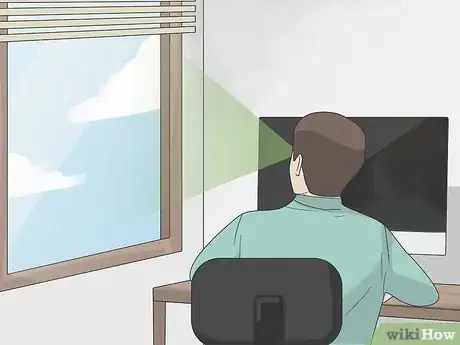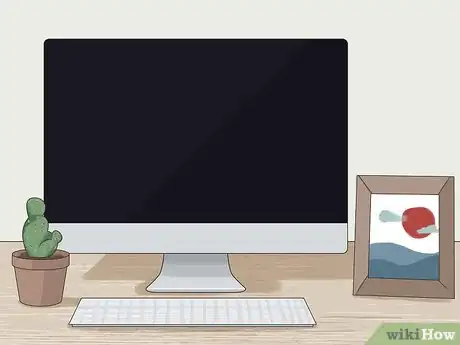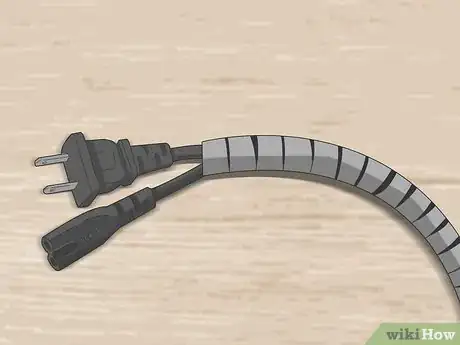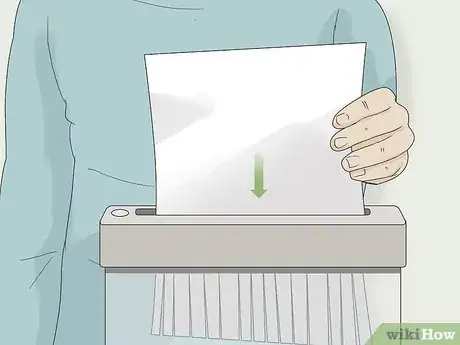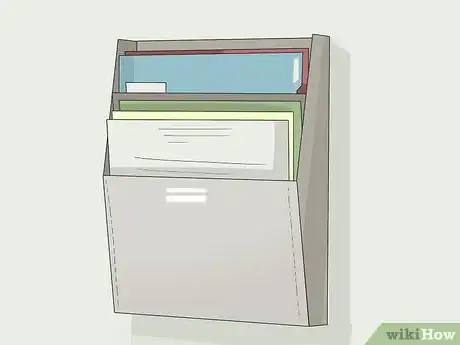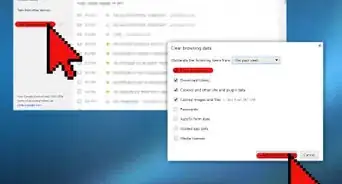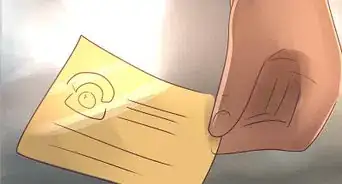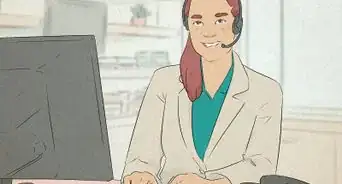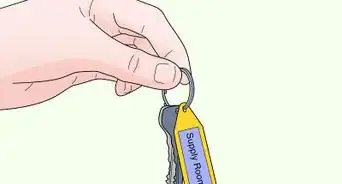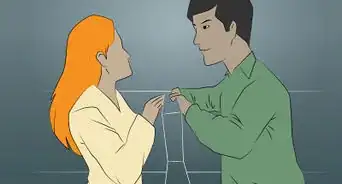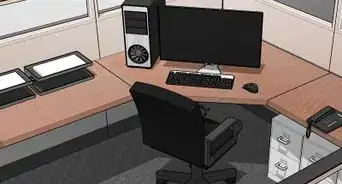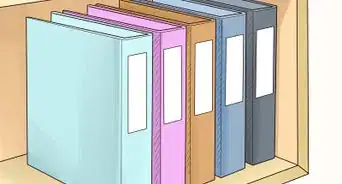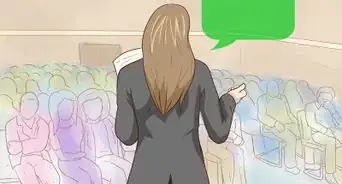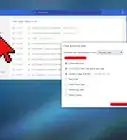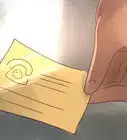This article was co-authored by Keith Bartolomei and by wikiHow staff writer, Hunter Rising. Keith Bartolomei is a Professional Organizer who runs his own consulting business called Zen Habitat based in the San Francisco Bay Area. Keith is a member of the National Association of Productivity and Organizing Professionals (NAPO), and is a Certified KonMari Consultant. He has over six years of organizational experience and has been trained in the art of tidying, including being trained by author of The Life Changing Magic of Tidying Up, Marie Kondo, and her team. He has been voted as one of the Best Home Organizers in San Francisco by Expertise in 2018 and 2019.
There are 10 references cited in this article, which can be found at the bottom of the page.
This article has been viewed 80,908 times.
A well-organized office can help improve your focus and efficiency while you’re working since you won’t have so much clutter. Once you put everything in a specific place, you’ll save more time trying to find it later. Try changing the layout of your office furniture to help you feel less stressed throughout the day. Once the layout of your office is set, organizing your office supplies and papers will make your office clean and uncluttered.
Steps
Adjusting the Layout
-
1Position your desk so you can look out a window if you can. Being able to look out a window while you work can help reduce stress levels and focus better on your work. Move your desk to a location where you can easily sit down and glance out the window occasionally. Check that there is no glare on your computer screen or light in your eyes throughout the day so you don’t get distracted or annoyed.[1]
- If you’re working in an open-plan office or a cubicle, talk to your office administrator or boss to see if it’s okay to change the position of your desk.
-
2Keep the things you use most frequently closest to you. Write lists of the things that you use daily, weekly, and monthly so you know what’s important to keep near you. Keep the things you use daily within arm’s reach of your desk so you can grab them when you need to. If you use things less frequently, store them in drawers or closets that are further away to remove clutter and save space.[2]
- For example, if you don’t use a printer often, keep it on the other side of the room so it’s not taking up space on your desk.
- If there are things that you use multiple times per day, keep them on your desk, a nearby shelf, or in the top drawer of your desk.
Advertisement -
3Get rolling furniture so you can move things out of the way easily. Look for organizers, shelves, or cabinets that have wheels so you can pull them out when you need to and then put them back. Keep shorter things, like filing cabinets or shelves, under your desk if you have room and only move them when you need to access them. Try using an office chair with wheels if you’re able so you can roll to a different part of your office to access something.[3]
-
4Keep a trash can in your office so you can get rid of things right away. Store a small bin to the side of your desk or underneath it if you have extra leg room. That way, if you have any trash or files that you don’t need anymore, you can throw them away immediately rather than letting them clutter up your space.[4]
- Be sure to change the garbage bag frequently so your office stays fresh and clean.
- Shred any documents with personal info on them before you throw them away.
Tip: If you go through a lot of paper, keep a separate bin in your office to use for recycling as well.
-
5Add a few personal touches to your office so you feel comfortable. Keep a few personal items in your office to make it your own space and so it doesn’t feel too sterile. Hang art on the walls or keep pictures on your desk to make your office a relaxing place to be. You can also keep small knick-knacks or plants somewhere on your desk as long as it doesn’t clutter your workspace.[5]
- Limit yourself to 1-2 items on your desk or else they might take up too much space.
Storing Your Supplies
-
1Get rid of any supplies you don’t use. Sort through the things you have in your office and determine how often you use them.[6] If you have any items that you rarely or never use, put them in a separate box or container. Once you go through your entire office, get rid of anything you have in the box so it doesn’t add any clutter.
- If you’re in an office building, put any unused supplies back in a supply closet so other people can take them if they need to.[7]
Tip: If you have a lot of pens or supplies that you don’t use, see if you can donate them to a school so teachers can use them in classrooms without having to buy new ones.
-
2Store pens and small office supplies in cups so you can access them easily. Place 1-2 cups on your desk within arm’s reach and place all your pens inside of them. Store other long office supplies, such as scissors in their own cups as well. Store the pens and supplies so they point down so you don’t accidentally hurt yourself when you try grabbing for something.[8]
- You can also buy desktop organizers that have various compartments if you don’t want to use multiple cups.
- Use glass mason jars if you want your desk to look more decorative.
-
3Use silverware trays to sort small office supplies. Get silverware trays that have multiple compartments so you can separate your office supplies. Store similar supplies together in the same section of the tray so you stay organized. Put the things you use often in front of the drawer and anything you use less toward the back.[9]
- You can also buy small plastic bins and lay them out inside your drawers however you want.
-
4Label containers or bins so you know what’s in them. Put items that you don’t use frequently inside storage bins and keep them in a closet or shelf if you can. Only put 1-2 different items in the same bin so they don’t get disorganized. Make paper labels for each of your bins and tape them on the side so you can see what’s stored in them at a glance. Be descriptive with your labels so you don’t get confused later on.[10]
- You can buy plastic storage bins from any department store or online.
-
5Get cord holders to remove visual clutter underneath your desk. Cords underneath your desk can look disorganized and easily tangle around your feet. Group all of your cables together and close them inside a cord holder so they aren’t all on the floor. Secure the cord holder against your wall or underneath your desk so your cables are organized.[11]
- You can buy cord holders from office supply stores or online.
- You can also secure cables together or to the side of your desk with Velcro strips or zip ties.
Removing Paper Clutter
-
1Shred any documents you don’t need that have personal information. Avoid throwing any documents that have things like account statements, legal documents, or credit card and social security numbers. Instead, get a paper shredder to destroy the documents so other people can’t steal the information. Once the papers are shredded completely, you can throw the scraps away as usual.[12]
- If you have important documents that you can’t get rid of, such as birth certificates, social security cards, or living wills, store them in a fireproof safe to protect them from any damage.
-
2Sort papers into a paper tray if you need to keep them on your desk. Paper trays have multiple tiers so you can separate different types of documents. Pick a vertical paper tray if you don’t have a lot of space, or a horizontal tray if you have some room to spare. Put the organizer near the edge of your desk so you can reach it easily throughout the day and grab what you need. Label each of the tiers so you know where certain documents should go.[13]
- You can buy paper trays from office supply stores.
- Paper trays also work great for holding folders or notebooks.
- Designate a section of your desk to stay clean so you have room to spread out if you need to.[14]
-
3Hang a wall pocket if you want to keep papers off your desk. Wall pockets are plastic trays that have multiple compartments to file documents and folders. Put a wall pocket near your desk so you can remove papers from your desk and reduce clutter. Make sure the different compartments are labeled so you don’t get confused later on.[15]
- Wall pockets can also be hung on the back of your door.
-
4Hang a bulletin board so you can easily glance at papers and memos. Find a place on your wall that has enough space for a bulletin board and put one up. Organize the bulletin board into sections where you can pin items, such as documents, receipts, sticky notes, and memos. Keep the most important documents visible and stack older ones underneath.[16]
- Many cubicles already have walls that you can put thumbtacks in.
- Use differently colored thumbtacks for each type of document you hang. For example, you may hang memos with blue pins and receipts with red ones.
- You can also pin personal photos if you don’t have space for them on your desk.
Tip: If you don’t have room for a full-sized bulletin board, you can also buy corkboard strips that have a small area where you can hang papers from.
-
5Color-code folders so they’re easy to recognize. Get file folders in various colors and sort your documents so similar ones all share a single color. For example, you may put different types of expenses in red folders and income forms in green folders. Label the tabs on the folders with what type of document is inside. Once you have your documents organized, put them in a filing cabinet in a paper tray so you can find them easily.[17]
- You can also attach colored labels to the tabs of file folders if you don’t want to buy multiple colors.
-
6Try storing memos and schedules digitally to avoid using paper. If you want to cut back on the amount of paper you’re using, try writing any of your notes or schedules on your computer. Create folders on your computer and sort your documents into them, or use an online program to organize your files. Once a file is outdated, delete it so it doesn’t clutter up your computer.[18]
- Backup any important documents on a cloud storage site or external hard drive so you don’t lose them if your computer ever crashes.
- If you have a scanner, you can upload physical documents onto your computer so you can get rid of the paper documents.
Expert Q&A
Did you know you can get expert answers for this article?
Unlock expert answers by supporting wikiHow
-
QuestionHow should I organize my desk at home?
 Keith BartolomeiKeith Bartolomei is a Professional Organizer who runs his own consulting business called Zen Habitat based in the San Francisco Bay Area. Keith is a member of the National Association of Productivity and Organizing Professionals (NAPO), and is a Certified KonMari Consultant. He has over six years of organizational experience and has been trained in the art of tidying, including being trained by author of The Life Changing Magic of Tidying Up, Marie Kondo, and her team. He has been voted as one of the Best Home Organizers in San Francisco by Expertise in 2018 and 2019.
Keith BartolomeiKeith Bartolomei is a Professional Organizer who runs his own consulting business called Zen Habitat based in the San Francisco Bay Area. Keith is a member of the National Association of Productivity and Organizing Professionals (NAPO), and is a Certified KonMari Consultant. He has over six years of organizational experience and has been trained in the art of tidying, including being trained by author of The Life Changing Magic of Tidying Up, Marie Kondo, and her team. He has been voted as one of the Best Home Organizers in San Francisco by Expertise in 2018 and 2019.
Professional Organizer & Certified KonMari Consultant
-
QuestionHow do you organize a small office?
 Keith BartolomeiKeith Bartolomei is a Professional Organizer who runs his own consulting business called Zen Habitat based in the San Francisco Bay Area. Keith is a member of the National Association of Productivity and Organizing Professionals (NAPO), and is a Certified KonMari Consultant. He has over six years of organizational experience and has been trained in the art of tidying, including being trained by author of The Life Changing Magic of Tidying Up, Marie Kondo, and her team. He has been voted as one of the Best Home Organizers in San Francisco by Expertise in 2018 and 2019.
Keith BartolomeiKeith Bartolomei is a Professional Organizer who runs his own consulting business called Zen Habitat based in the San Francisco Bay Area. Keith is a member of the National Association of Productivity and Organizing Professionals (NAPO), and is a Certified KonMari Consultant. He has over six years of organizational experience and has been trained in the art of tidying, including being trained by author of The Life Changing Magic of Tidying Up, Marie Kondo, and her team. He has been voted as one of the Best Home Organizers in San Francisco by Expertise in 2018 and 2019.
Professional Organizer & Certified KonMari Consultant Create a vision of your ideal office space. Asses your current space by taking note of what's not working and what is working. Choose your selection criteria based on your vision. Break your small office down into categories, e.g., books, papers, office supplies, electronics, job-specific items, personal care items, food, and sentimental. Category by category, sort the items into sub-categories if necessary, decide what to keep, and then store what remains by using bins and boxes, making sure that everything can be seen at a glance.
Create a vision of your ideal office space. Asses your current space by taking note of what's not working and what is working. Choose your selection criteria based on your vision. Break your small office down into categories, e.g., books, papers, office supplies, electronics, job-specific items, personal care items, food, and sentimental. Category by category, sort the items into sub-categories if necessary, decide what to keep, and then store what remains by using bins and boxes, making sure that everything can be seen at a glance. -
QuestionHow do I organize my office paperwork?
 Keith BartolomeiKeith Bartolomei is a Professional Organizer who runs his own consulting business called Zen Habitat based in the San Francisco Bay Area. Keith is a member of the National Association of Productivity and Organizing Professionals (NAPO), and is a Certified KonMari Consultant. He has over six years of organizational experience and has been trained in the art of tidying, including being trained by author of The Life Changing Magic of Tidying Up, Marie Kondo, and her team. He has been voted as one of the Best Home Organizers in San Francisco by Expertise in 2018 and 2019.
Keith BartolomeiKeith Bartolomei is a Professional Organizer who runs his own consulting business called Zen Habitat based in the San Francisco Bay Area. Keith is a member of the National Association of Productivity and Organizing Professionals (NAPO), and is a Certified KonMari Consultant. He has over six years of organizational experience and has been trained in the art of tidying, including being trained by author of The Life Changing Magic of Tidying Up, Marie Kondo, and her team. He has been voted as one of the Best Home Organizers in San Francisco by Expertise in 2018 and 2019.
Professional Organizer & Certified KonMari Consultant Aim to discard as much as possible. Discard documents that you can access elsewhere. File the remaining papers in as few folders as possible based on when you can get rid of them, not based on topic (e.g., papers that can be kept once you complete an action, papers that need to be kept for a limited amount of time, and papers that you need to keep forever). Shorten the file names based on your preferences.
Aim to discard as much as possible. Discard documents that you can access elsewhere. File the remaining papers in as few folders as possible based on when you can get rid of them, not based on topic (e.g., papers that can be kept once you complete an action, papers that need to be kept for a limited amount of time, and papers that you need to keep forever). Shorten the file names based on your preferences.
References
- ↑ http://www.lonny.com/See+It+Now/articles/H3X1rUjgRoC/How+Organize+Office+Can+Change+How+Work
- ↑ https://youtu.be/kU5U4AZZ3pg?t=85
- ↑ http://www.oprah.com/home/peter-walshs-ten-steps-to-home-office-organization/all
- ↑ https://blog.managedbyq.com/how-to-declutter-and-organize-your-office
- ↑ https://www.roberthalf.com/blog/salaries-and-skills/how-to-organize-your-desk-for-maximum-efficiency
- ↑ Keith Bartolomei. Professional Organizer & Certified KonMari Consultant. Expert Interview. 2 January 2020.
- ↑ http://www.oprah.com/home/peter-walshs-ten-steps-to-home-office-organization/all
- ↑ https://www.homedit.com/diy-cubicle-organization/
- ↑ https://www.cio.com/article/2404456/how-to-organize-your-office-and-boost-your-productivity.html
- ↑ https://youtu.be/o5_GlULF06U?t=57
- ↑ https://blog.managedbyq.com/how-to-declutter-and-organize-your-office
- ↑ https://portal.ct.gov/DCP/Common-Elements/Common-Elements/Guidelines-for-Shredding-and-Saving-Personal-Documents
- ↑ https://www.cio.com/article/2404456/how-to-organize-your-office-and-boost-your-productivity.html
- ↑ https://www.roberthalf.com/blog/salaries-and-skills/how-to-organize-your-desk-for-maximum-efficiency
- ↑ https://www.cio.com/article/2404456/how-to-organize-your-office-and-boost-your-productivity.html
- ↑ https://www.roberthalf.com/blog/salaries-and-skills/how-to-organize-your-desk-for-maximum-efficiency
- ↑ http://www.oprah.com/home/peter-walshs-ten-steps-to-home-office-organization/all
- ↑ https://www.roberthalf.com/blog/salaries-and-skills/how-to-organize-your-desk-for-maximum-efficiency
- ↑ http://www.oprah.com/home/peter-walshs-ten-steps-to-home-office-organization/all
